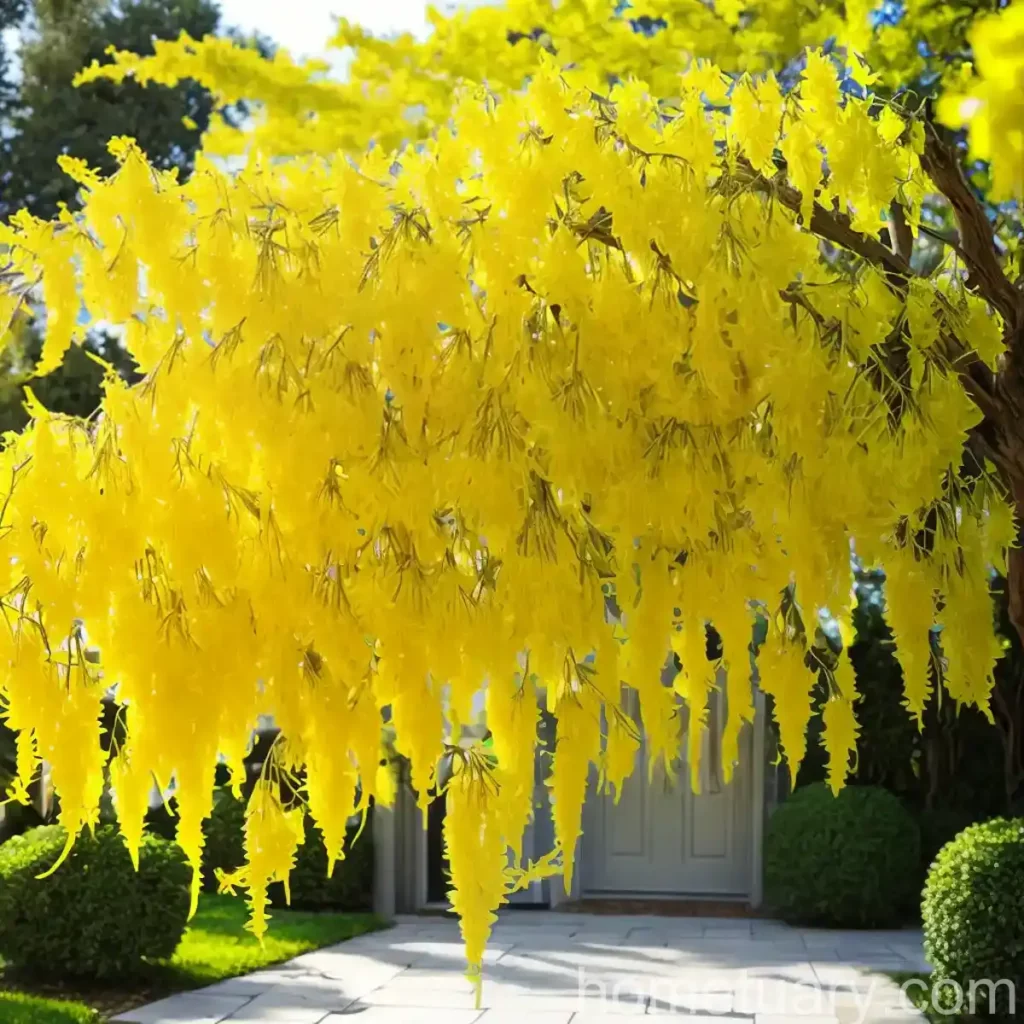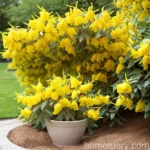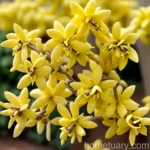Weeping Forsythia (Forsythia suspensa): An In-Depth Guide to Cultivation and Care
Weeping forsythia, scientifically known as Forsythia suspensa, is a stunning deciduous shrub that belongs to the olive family (Oleaceae). This beautiful plant is native to East Asia and is revered for its graceful, arching branches laden with bright yellow flowers. Weeping forsythia is a popular choice for gardens and landscapes due to its striking floral display and ease of cultivation.
In this comprehensive guide, we will delve into the world of weeping forsythia, exploring its cultural requirements, uses, maintenance, and common diseases and pests. Whether you’re a seasoned gardener or a novice enthusiast, this article aims to provide you with invaluable insights into the care and cultivation of this remarkable plant.
What is Weeping Forsythia (Forsythia suspensa)?
Weeping forsythia, also known as golden bell, is a deciduous shrub prized for its abundant and vibrant yellow flowers that typically emerge in early spring, heralding the arrival of the new season. As the name suggests, the branches of this cultivar gracefully cascade downward, creating a stunning weeping effect that adds elegance and drama to any landscape.
Key Takeaways – Weeping Forsythia (Forsythia suspensa)
Before we delve into the specifics of cultivating and caring for weeping forsythia, let’s outline the key takeaways associated with this stunning plant:
- Scientific Name: Forsythia suspensa
- Common Name: Weeping forsythia or golden bell
- Plant Type: Deciduous shrub
- Flower Color: Bright yellow
- Seasonal Interest: Early spring bloomer
- Notable Feature: Graceful, weeping branches
Now that we have a foundational understanding of weeping forsythia, let’s explore the essential aspects of cultivating and caring for this remarkable plant.
1. Culture
Cultivating weeping forsythia successfully requires an understanding of its specific cultural requirements. From choosing the right location to providing suitable soil conditions, here’s what you need to know to ensure the optimal growth and development of this beautiful shrub.
Uses
Weeping forsythia is highly versatile and can be utilized in various ways within a garden or landscape setting:
- Accent Plant: Its arching branches and vibrant flowers make weeping forsythia an excellent choice as an accent plant, adding visual interest and a burst of color to the landscape.
- Hedging: Due to its dense growth habit, weeping forsythia can be used to create beautiful, natural hedges that provide both visual appeal and privacy.
- Mass Planting: When planted en masse, weeping forsythia can create a striking visual impact, especially when in full bloom.
Water
Weeping forsythia prefers moist, well-draining soil, especially during its establishment phase. Once established, it is relatively drought-tolerant, though regular watering during prolonged dry spells can help maintain its vigor and floral display.
Here are some essential watering guidelines for weeping forsythia:
- Establishment Phase: Water deeply and regularly during the first growing season to facilitate robust root development.
- Mature Plants: Provide supplemental watering during extended periods of drought to prevent dehydration and stress, particularly in regions with limited rainfall.
Sunlight
Weeping forsythia thrives in full sun to partial shade, making it well-suited for a wide range of garden settings. However, it typically produces the most abundant and vibrant blooms when exposed to full sunlight for the majority of the day.
Here’s a comprehensive guide to optimal sunlight conditions for weeping forsythia:
- Full Sun: Ideally, provide at least 6-8 hours of direct sunlight daily for the best flowering performance.
- Partial Shade: While weeping forsythia can tolerate partial shade, ensure that it still receives a minimum of 4-6 hours of sunlight to support healthy growth and flowering.
Fertilizer
Applying a balanced, slow-release fertilizer in early spring can provide the necessary nutrients to support robust growth and prolific flowering. Look for a fertilizer with a balanced NPK ratio, such as 10-10-10 or 20-20-20, to supply essential macronutrients in a readily available form.
Consider the following fertilizer application guidelines for weeping forsythia:
- Early Spring: Apply a granular, balanced fertilizer around the base of the shrub, ensuring even distribution.
- Watering In: After applying the fertilizer, water the shrub thoroughly to facilitate the incorporation of nutrients into the soil and encourage uptake by the roots.
Soil
Weeping forsythia thrives in moderately fertile, well-draining soil with a slightly acidic to neutral pH range. When planting this shrub, it is essential to ensure that the soil offers adequate aeration and water drainage to prevent waterlogging and root rot.
Here are the key soil requirements for weeping forsythia:
- Well-Draining: Choose a planting site with soil that drains well to prevent water accumulation around the roots, which can lead to fungal diseases and other issues.
- pH Range: Aim for a soil pH level between 6.0 and 7.0, which is conducive to the efficient uptake of essential nutrients by the plant.
2. Pruning
Pruning is a critical aspect of maintaining the health and aesthetics of weeping forsythia. Proper pruning not only promotes flowering and new growth but also helps to shape the plant and prevent overgrowth.
When to Prune
The best time to prune weeping forsythia is immediately after it has finished flowering, typically in late spring to early summer. Pruning at this time allows the plant to set new buds for the following year’s blooms while still providing ample time for new growth to establish before the onset of winter.
Key considerations for pruning weeping forsythia include:
- Post-Flowering Period: Schedule pruning for the period immediately following the conclusion of the spring bloom, as this allows ample time for new growth and bud formation.
Pruning Techniques
When pruning weeping forsythia, it is crucial to employ the appropriate techniques to maintain its natural form and encourage healthy growth. The following techniques are recommended for effective weeping forsythia pruning:
- Selective Pruning: Remove dead, damaged, or diseased branches to promote overall plant health and vigor.
- Thinning: Thin out crowded growth to improve air circulation, reduce the risk of disease, and promote the penetration of sunlight into the shrub’s interior.
3. Propagation
Weeping forsythia can be propagated through several methods, including softwood cuttings, hardwood cuttings, and division. Propagating new weeping forsythia plants is an excellent way to expand your garden or share this beautiful shrub with others.
Softwood Cuttings
Softwood cuttings are typically taken in late spring to early summer when the current season’s growth is still green and flexible. Use the following steps to propagate weeping forsythia from softwood cuttings:
- Select Healthy Cuttings: Choose a healthy, non-flowering stem and make a clean, angled cut to obtain a 4-6 inch section.
- Prepare the Cuttings: Remove the lower leaves, leaving only a few sets of leaves at the tip of the cutting.
- Rooting Hormone: Dip the cut end of the stem in rooting hormone to stimulate the development of roots.
- Planting Medium: Place the cuttings in a well-draining potting mix and provide consistent moisture to encourage root development.
Division
Dividing established weeping forsythia plants is another effective method of propagation. This can be conducted during the plant’s dormant season and involves separating the root mass into smaller sections, each with its own set of stems and shoots.
4. Container Popularity
Weeping forsythia can be successfully grown in containers, making it a desirable choice for urban gardens, patios, and smaller landscapes. When cultivating this plant in containers, it is essential to provide the appropriate growing conditions and care to support its health and vitality.
Container Common Diseases
While weeping forsythia is generally resilient, it can be susceptible to certain diseases, particularly when grown in containers or other restrictive environments. Common diseases that may affect weeping forsythia in containers include:
- Powdery Mildew: A fungal disease characterized by the development of a powdery white coating on the leaves, stems, and flowers.
- Root Rot: Excessive moisture and poor drainage in container-grown plants can lead to root rot, resulting in wilting, yellowing foliage, and overall decline.
Disease Diagnosis
Timely diagnosis of diseases affecting weeping forsythia is crucial for implementing appropriate management strategies. Symptoms to watch for when diagnosing common diseases in container-grown weeping forsythia include:
- Powdery Mildew: White, powdery spots on the leaves, often accompanied by distorted growth and reduced vigor.
- Root Rot: Wilting, yellowing foliage, and a general decline in the plant’s health despite regular watering and fertilization.
5. Common Pests
Maintaining vigilance against common pests is essential to preserve the health and vitality of weeping forsythia. While relatively resistant to pest infestations, some insects may pose a threat to this plant and require targeted management measures.
Pest Management
Several common pests can potentially impact weeping forsythia, including:
- Aphids: These small, sap-sucking insects can congregate on the undersides of leaves, causing distortion and yellowing of the foliage.
- Scale Insects: Scale insects can appear as small, immobile bumps on the stems and leaves, sapping the plant’s resources and causing stunted growth.
Botanist’s Tips
As a plant scientist with a passion for cultivating and studying diverse plant species, I’ve gathered a few essential tips for ensuring the successful cultivation and care of weeping forsythia. These botanist’s tips can help you maximize the health and beauty of your weeping forsythia plants:
- Regular Monitoring: Vigilance is key to the early detection of pests, diseases, or nutrient deficiencies that may affect weeping forsythia.
- Optimal Pruning: Adhering to proper pruning techniques and timing can significantly impact the plant’s growth, form, and floral display.
- Soil Testing: Periodic soil testing can provide invaluable insights into the soil’s nutrient levels and pH, guiding your fertilization and amendment efforts.
Fun Facts
- Weeping forsythia is named after William Forsyth, a prominent Scottish botanist who served as a royal head gardener at Kensington Palace in the 18th century.
- In traditional Chinese medicine, the fruit of Forsythia suspensa is used to create natural remedies, believed to have anti-inflammatory and anti-fever properties.
Links to External Resources
For further information on weeping forsythia care and cultivation, consider exploring the following resources:
- The Royal Horticultural Society – Forsythia Propagation
- University of California Statewide Integrated Pest Management Program – Powdery Mildew Management
- Missouri Botanical Garden – Weeping Forsythia Landscape Ideas
In conclusion, weeping forsythia (Forsythia suspensa) is a captivating and resilient shrub that offers a wealth of ornamental value to gardens and landscapes. By understanding and adhering to its cultural requirements, employing proven care techniques, and remaining attuned to potential challenges, you can create a thriving, picturesque display of weeping forsythia in your outdoor spaces. Whether used as a standalone focal point or incorporated into mixed borders, this charming shrub is sure to captivate with its exuberant blooms and graceful, weeping form.















